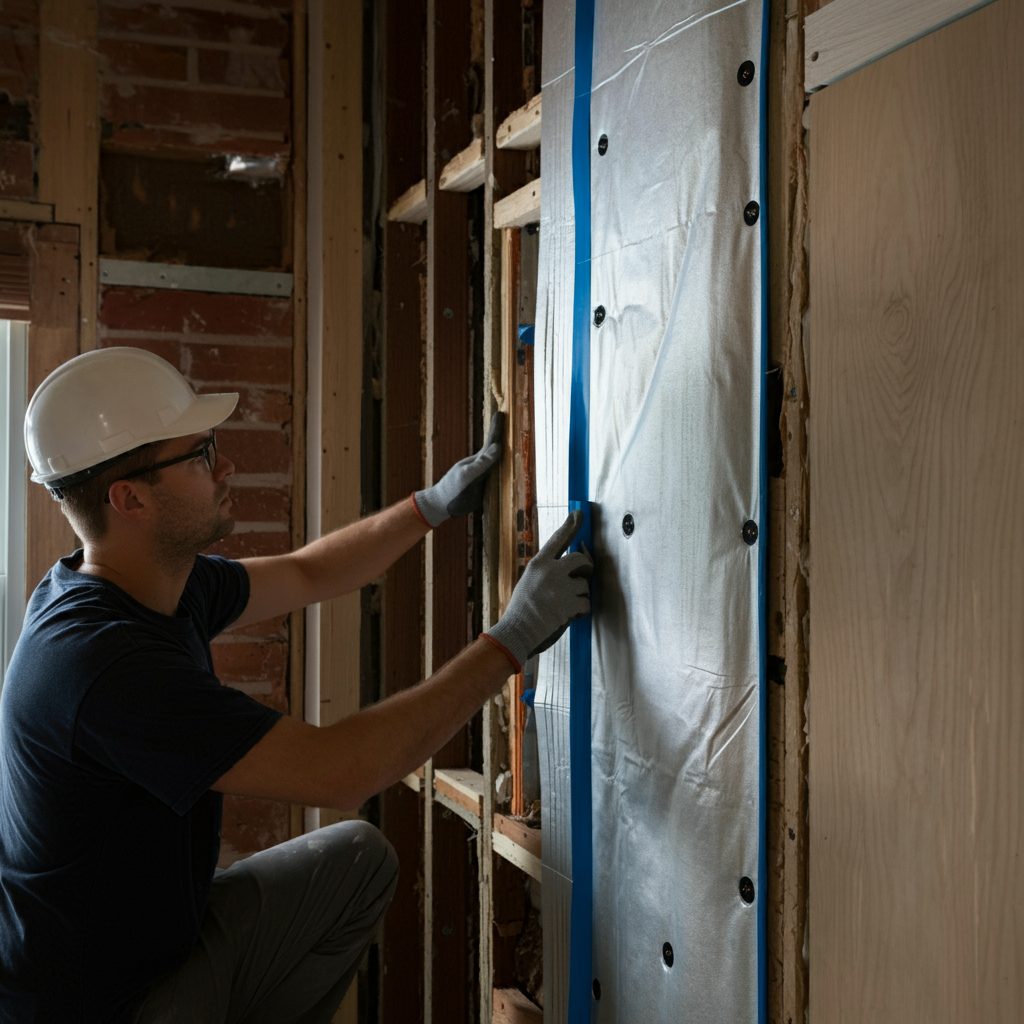Protect Your Home: Expert Moisture Management for Renovations in New York
Effective strategies for moisture control and energy-efficient building envelopes tailored to New York’s climate.
Why Moisture Management is Crucial in New York
New York’s weather is known for heavy rains, humid summers, and cold, snowy winters. These conditions can wreak havoc on a home’s structure if moisture control isn’t prioritized during renovations. Ignoring this issue can lead to severe consequences, including mold, structural decay, and costly repairs.
Have you noticed damp or musty smells in your basement? This could be a sign that moisture is compromising your home’s integrity. Let’s dive into strategies to prevent these problems.
Understanding Moisture Threats in New York
Let’s break down the key moisture threats faced by New York homeowners:
- Heavy Rainfall: Intense storms, particularly in late spring and summer, can lead to water infiltration in basements and lower levels.
- Snowmelt and Freeze-Thaw Cycles: Winter snow melting combined with fluctuating temperatures can cause foundation cracks and moisture seepage.
- High Humidity: The humid summer air can lead to indoor condensation, especially in poorly ventilated areas.
Did you know? Even minor moisture problems can escalate if left untreated. What steps are you taking to protect your home from moisture?
Proven Strategies for Moisture Control in Renovations
1. Site Grading and Drainage Systems
Ensuring proper site grading is one of the most fundamental ways to keep water away from your home. Ideally, the ground should slope away from your foundation, with a minimum slope of 6 inches over the first 10 feet.
Consider installing a perimeter drainage system, such as a French drain, to manage groundwater. This can be especially critical if your home is built on a slope or in a flood-prone area.

Have you checked your home’s drainage system recently? A proactive inspection can prevent water damage before it starts.
2. Foundation Waterproofing Techniques
Basement waterproofing is crucial for New York homes, where heavy rain and snowmelt often cause water issues. Start by applying a waterproof membrane to the exterior foundation walls. For interior protection, use a vapor barrier to minimize humidity transfer.
Sealing cracks and applying protective coatings can further enhance your home’s defenses. Is your basement ready for the next big storm? Waterproofing now can save you from headaches down the road.
3. Insulation and Thermal Protection
Proper insulation isn’t just about comfort; it’s also about moisture control. Closed-cell spray foam insulation is a top choice for New York homes because it acts as both an insulator and a moisture barrier. It is particularly effective in preventing condensation and heat loss.
When insulating walls, attics, and basements, make sure to seal gaps and cracks to avoid thermal bridging. This helps prevent warm air from meeting cold surfaces, which often leads to moisture problems.
Are you using the right insulation for your climate? Choosing the correct materials can make a world of difference.
4. Advanced Ventilation Solutions
Ventilation is essential for controlling indoor humidity, especially during humid New York summers and cold winters. An energy recovery ventilator (ERV) can be a game-changer, balancing air quality while maintaining energy efficiency.
In basements and crawl spaces, use dehumidifiers to keep humidity levels below 60%. Do you have proper airflow in your home? Good ventilation can improve both your air quality and moisture control.
Optimizing the Building Envelope for Moisture Control
Your home’s building envelope (walls, roof, foundation, windows, and doors) is its primary defense against the elements. Here’s how to reinforce it:
- Roof Design: Use durable, water-resistant roofing materials and make sure your gutters and downspouts are in top shape, directing water away from your foundation.
- Siding and Cladding: Opt for moisture-resistant materials like fiber cement or treated wood to withstand New York’s weather extremes.
- Window Flashing: Properly install and seal windows with modern flashing materials to keep water out and your interior dry.
When was the last time you checked your window seals? Regular maintenance can prevent water damage and energy loss.
Choosing the Best Materials for Moisture Management
Material selection plays a crucial role in protecting your home. Use this guide to pick moisture-resistant and long-lasting options:
| Material | Properties | Ideal Applications | |
|---|---|---|---|
| Closed-Cell Spray Foam | High R-value, vapor barrier properties | Walls, attics, and basements | |
| Waterproof Membranes | Impermeable, durable protection | Exterior foundation walls | Exterior foundation walls |
| Fiber Cement Siding | Resistant to moisture, fire, and pests | Exterior cladding | |
| Drainage Mats | Facilitate water flow and prevent soil contact | Behind foundation walls, under basements | |
| Geotextiles | Prevent soil erosion, promote drainage | Under landscaping, around foundations |
Remember, choosing materials that are specifically designed for New York’s climate conditions will give you the best long-term protection. Have you considered how material choices impact your home’s durability? Making informed decisions now can prevent issues later.
Case Studies: Successful Moisture Control in New York
Real-world examples can illustrate how effective moisture control strategies make a difference. Here are two inspiring cases:
Brooklyn Brownstone Restoration
A historic brownstone in Brooklyn suffered from chronic basement flooding and wall dampness. The renovation involved extensive waterproofing, including the installation of exterior membranes and French drains. Closed-cell spray foam insulation was used to seal walls and prevent condensation. The result? A dry, comfortable basement that added valuable living space to the home.

Would you like to turn your basement into a livable space? Proper moisture control can make that dream a reality.
Suburban Westchester Upgrade
In Westchester, a suburban home faced attic condensation and basement mold issues. The homeowners addressed these with a comprehensive approach: they installed an ERV system for balanced ventilation, added vapor barriers, and upgraded to fiber cement siding. By sealing air leaks and insulating correctly, the home is now energy-efficient and moisture-resistant.

Are you struggling with similar issues? A holistic renovation approach can protect your home from New York’s harsh weather.
Long-Term Maintenance for Moisture Control
Renovation is just the first step. Maintaining moisture control requires ongoing care and attention. Here are some maintenance tips:
- Inspect your roof annually for any signs of damage or leaks. Replace damaged shingles promptly.
- Check the grading around your home regularly. Soil can shift over time, so adjust as needed to maintain proper water drainage.
- Examine your home’s exterior caulking and weather stripping, especially around windows and doors, to keep water out.
- Monitor indoor humidity levels using a hygrometer. Keep levels between 30% and 50% to prevent mold growth.
Remember, prevention is always easier and less expensive than remediation. What’s your current maintenance routine? Small steps today can save significant costs in the future.
Frequently Asked Questions
Still have questions about moisture control and renovations? Here are some common concerns from New York homeowners:
1. How can I tell if my basement has a serious moisture problem?
Look for signs like persistent damp smells, visible mold, or water stains on the walls and floor. You might also notice peeling paint or efflorescence, which is a white, powdery substance left by water evaporating through concrete.
2. Is it worth investing in exterior waterproofing?
Yes, exterior waterproofing is one of the most effective ways to protect your basement from water damage. While it can be a significant investment, it saves you money in the long run by preventing structural damage and mold remediation costs.
3. What type of insulation is best for New York’s climate?
Closed-cell spray foam is highly recommended because of its dual function as an insulator and moisture barrier. It helps keep heat inside during the winter and blocks moisture infiltration year-round.
4. Can landscaping help with moisture control?
Absolutely. Strategic landscaping, like using native plants that require less watering and adding mulch to help soil retain moisture, can improve drainage and reduce the risk of water pooling near your foundation.
5. How do I know if I need a professional assessment?
If you’re dealing with recurring water issues or can’t pinpoint the source of moisture, it’s best to call a professional. They can perform a comprehensive assessment and suggest the most effective solutions for your home.






